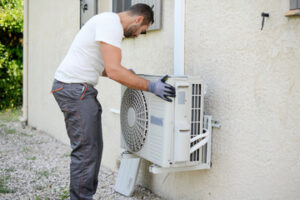HVAC Round Rock systems are the backbone of indoor comfort. They’re found in single-family homes, submarines and everything in between, providing heating and cooling to regulate the temperature and air quality.

Understanding how it works is important to keep it running properly. But it’s also important to be aware of the potential pitfalls.
When it comes to heating, ventilation and air conditioning systems, reliability is a top priority. Especially in commercial facilities, reliable HVAC equipment is essential to maintain productivity and ensure employee safety. Regular maintenance can help prevent unexpected breakdowns, extend equipment lifespan, and improve energy efficiency. In addition, reliable HVAC services can also help meet industry regulations and maintain indoor environmental quality.
Reliable HVAC systems deliver comfortable interior temperatures all year round, providing warmth in the winter and cooling relief during the summer. They are also essential to maintaining healthy home environments, ensuring air quality that is free of pollutants and allergens. In order to maximize energy efficiency and prolong the lifespan of your system, it is important to have a trusted HVAC contractor perform routine maintenance. Asking for recommendations, verifying certifications, checking customer reviews, and confirming brand coverage are all crucial elements to finding the right professional.
The most reliable HVAC systems have been extensively tested by manufacturers to ensure quality and performance. The most common testing include subjecting the system to a wide range of conditions and simulated usage scenarios. In addition, some HVAC brands have their own reliability programs and warranties that are designed to support the longevity of their products.
HVAC systems are complex and have many components, so it is critical to have a skilled technician install and service them. Improper installation can result in decreased efficiency, reduced lifespan, and costly repairs. In fact, if you notice that your HVAC system is running less efficiently, it may be time for an upgrade.
In addition to increasing energy efficiency, an HVAC system upgrade can also reduce utility bills. In some cases, replacing old equipment with newer equipment can save you up to 30% on your energy costs.
Investing in a dependable HVAC system can help you save money and stay comfortable all year round. Whether you’re looking for heating or cooling, choosing the best professionals can be daunting, but with a little effort, you can find the right person to do the job. Asking for recommendations, verifying certifications, and checking customer reviews are all crucial to finding a reputable HVAC company.
Energy Efficiency
An HVAC system’s energy efficiency impacts its power consumption, utility bills and environmental impact. The good news is that upgrading to a more energy-efficient system can make a significant difference in all of these areas. This can be achieved through equipment replacement or add-on technologies. These upgrades help reduce energy waste by optimizing the system’s operation to match its actual cooling and heating needs.
These systems use smart controls to monitor and reset temperature setpoints based on external weather conditions or internal load changes. This maximizes energy efficiency across the entire climate control system. Additionally, new technologies like variable-speed motors and programmable thermostats provide improved energy efficiency by using less power to achieve the same results.
Another way that HVAC systems can improve their energy efficiency is through better insulation and air sealing. These improvements can minimize heat transfer and prevent conditioned air from escaping or leaking into unoccupied spaces. This keeps the system from working harder than necessary to maintain a comfortable indoor environment.
Eco-friendly HVAC systems are also often designed to reduce indoor air pollution and carbon emissions. These systems can include advanced filtration technologies that capture and remove pollutants, including allergens and harmful gases, from indoor air. This can help reduce the symptoms of allergies and asthma.
In addition, many of these systems are powered by forms of sustainable energy instead of fossil fuels, reducing greenhouse gas production and environmental impact. Hybrid HVAC systems are particularly popular, as they combine fossil fuels with renewable energy sources to produce clean, green energy without the need for oil or natural gas.
Upgrading to an energy-efficient HVAC system can be a great investment for homeowners. In addition to saving on energy costs, these systems can also increase the resale value of a home. Potential buyers are willing to pay more for homes that are more energy efficient, as they offer lower energy bills and a reduced impact on the environment. This makes it a good idea for homeowners to look for systems with high efficiency ratings and ENERGY STAR certification when shopping for an HVAC system.
Maintenance
Performing regular maintenance is the best way to keep your HVAC system running well. It prevents issues and extends the life of the equipment. It also saves money on energy bills. In addition, it reduces the amount of repairs needed.
A good maintenance program will include regular inspections of the ductwork and the evaporator coil, as well as an examination of all electrical connections and parts. These inspections help identify problems that are not obvious to the untrained eye. This can include loose or worn-out wires, faulty capacitors, and improperly installed or plugged-in thermostats. In addition, the technician will check the air filters and replace them as needed.
The air ducts should be regularly cleaned, as they can be a source of allergens and dust. They also need to be brushed and cleared of any debris. If the ductwork is clogged, it can lead to a significant increase in energy costs and damage the equipment. A qualified technician can clean the ductwork with a vacuum cleaner or hose.
HVAC systems are complex and need regular care to keep them functioning efficiently. In addition to cleaning the air filters, the technician can check the refrigerant level, and inspect all electrical components for wear and tear. He can also test the system performance to identify any potential problems and correct them before they escalate.
Getting your system on a maintenance plan helps you stay organized and makes it easy to schedule service calls. A maintenance plan will include a detailed record of inspections and work orders completed, as well as an estimate of repair and replacement costs. It is a great way to manage maintenance expenses and protect your investment.
The maintenance schedule of your HVAC system should be adjusted to reflect the changing seasons. A spring/summer schedule is vital for cooling your property, while a fall/winter schedule will keep your furnace working properly. During these routine maintenance visits, the professional will inspect and adjust the thermostat, examine the electrical connections and lubricate all moving parts. He will also ensure that the gas pressure is correct, and that the flue system is free of obstructions or leaks.
Cost
Depending on the type of system you choose, the size of your home or commercial building and other factors, the cost of an HVAC system can vary. It is important to consider your budget before making a decision. In addition, the quality of your installation is also a factor in the overall cost of your new HVAC system. Choosing a lower-quality system and/or hiring inexperienced technicians may save you upfront costs, but could end up costing you more in repairs and maintenance down the road.
The cost of an HVAC system can vary based on the type, size and complexity of the installation. For example, a central heating and cooling system requires ductwork, which can add to the cost. On the other hand, a mini-split system can be more cost-effective for smaller spaces because it does not require ductwork.
Another important factor in the cost of an HVAC system is its energy efficiency. A higher-efficiency system uses less electricity to operate, resulting in lower energy bills. The energy-efficiency rating of an HVAC system is typically indicated by its Seasonal Energy Efficiency Ratio (SEER).
The higher the SEER rating, the more efficient the system. An HVAC system with a high SEER rating will likely have a higher upfront cost, but will pay for itself in reduced utility costs over time.
Many people consider an HVAC system as a long-term investment, and installing an advanced system can boost a property’s value. In addition to increased comfort, an HVAC system can also improve indoor air quality and reduce allergens.
In addition to HVAC systems, HVAC control systems are used in larger facilities as part of a larger system known as a building automation or energy management system. These systems are used to monitor and control a variety of equipment, including lighting, fire alarms and access/security systems.
A good quality HVAC system can be a smart purchase for any property owner, as it will offer improved comfort and energy savings. It can also improve the value of a property when it comes time to sell. However, it is important to keep in mind that a cheap or low-quality system will not perform as well as a more expensive system.


